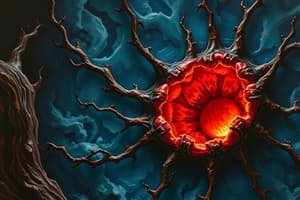Podcast
Questions and Answers
What is liquefactive necrosis and in what situations is it commonly seen?
What is liquefactive necrosis and in what situations is it commonly seen?
Liquefactive necrosis is a type of necrosis where dead cells are completely digested, resulting in transformation of the affected tissue into a liquid viscous mass enclosed within a cystic cavity. It is commonly seen in situations of focal bacterial infection (or occasionally fungal infections) and ischemic destruction of brain tissue.
What is the process that leads to liquefactive necrosis in cases of bacterial infection?
What is the process that leads to liquefactive necrosis in cases of bacterial infection?
In cases of bacterial infection, microbes stimulate the accumulation of inflammatory cells and the enzymes of the leukocytes digest (liquefy) the tissue, leading to liquefactive necrosis.
What is the term used to describe a limb, generally the lower leg, that has lost its blood supply?
What is the term used to describe a limb, generally the lower leg, that has lost its blood supply?
Gangrenous necrosis is the term used to describe a limb, generally the lower leg, that has lost its blood supply.
Is gangrenous necrosis a distinctive pattern of cell death?
Is gangrenous necrosis a distinctive pattern of cell death?
What is the appearance of liquefied material in cases of pyogenic bacterial infection?
What is the appearance of liquefied material in cases of pyogenic bacterial infection?
What are the morphological characteristics of coagulative necrosis?
What are the morphological characteristics of coagulative necrosis?
Which type of necrosis is most commonly observed?
Which type of necrosis is most commonly observed?
What is the typical appearance of caseous necrosis?
What is the typical appearance of caseous necrosis?
Which type of necrosis is characterized by the hydrolytic action of lipases on fat?
Which type of necrosis is characterized by the hydrolytic action of lipases on fat?
What happens to fatty acids released via hydrolysis in enzymatic fat necrosis?
What happens to fatty acids released via hydrolysis in enzymatic fat necrosis?
Flashcards are hidden until you start studying




